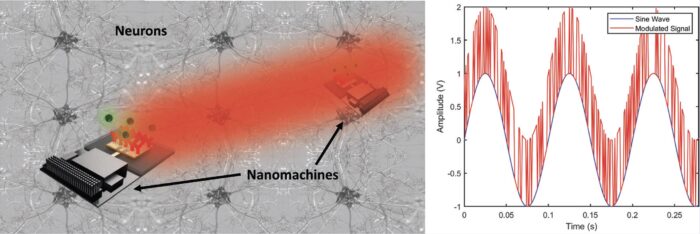Josep Jornet
Professor of Electrical and Computer Engineering

A joint nano-communication and bio-actuation system that leverages optical signals to simultaneously stimulate neurons or the neurons’ genome and transmit information among nearby nanomachines. The much faster information signal super-imposed on the slowly changing neuron-excitation signal is imperceptible by the neurons.
The ability to manipulate matter at the atomic and molecular scale has unlocked new possibilities for creating devices with extraordinary physical properties. One field that has greatly benefitted from this breakthrough is wireless communications, with the development of miniature transceivers and antennas operating in uncharted frequency bands of the electromagnetic spectrum. In one of the most recent papers, researchers at WIoT Institute explore the state of the art in electromagnetic nanoscale communication and networks, emphasizing a bottom-up approach to reveal the immense potential of this technology. Innovative applications, fundamental physical properties, and tailored communication solutions are discussed, highlighting a roadmap to bring socially meaningful applications into reality.
Researchers have ventured into traditionally unexplored frequency bands of the electromagnetic spectrum by designing miniature transceivers and antennas. These developments hold promise for transformative applications across various scales, from nano to macro, and domains spanning biological and non-biological systems. The application of this technology ranges from classical to quantum realms, revolutionizing how we interact with the world around us.
Starting from the basic building blocks at the nanoscale, they have constructed communication solutions that transcend conventional limitations. This approach allows for a more profound understanding of the underlying phenomena, which play a crucial role in the propagation of signals at optical and terahertz frequencies. By harnessing nanoscale communication, researchers have unlocked potential applications in diverse fields, ranging from medical diagnostics and treatment to environmental monitoring and smart infrastructure.
To fully grasp the potential of electromagnetic nanoscale communication, examining the fundamental physical properties and capabilities of nano-transceivers and nano-antennas at optical and terahertz frequencies is essential. By understanding the wave and particle perspectives affecting signal propagation, researchers can fine-tune these devices to achieve optimal performance.
This paper explores the state of the art in electromagnetic nanoscale communication and networks. It also dives deep into the possibility of controlling matter at the atomic and molecular scale to develop new types of devices that will lead to the creation of transformative applications with a wide range of impacts across different scales (from nano to macro).
The possibility to control matter at the atomic and molecular scale opens the door to new types of devices that exhibit unprecedented physical properties. For the wireless communications community, the development of miniature transceivers and antennas that operate in traditionally uncharted frequency bands of the electromagnetic spectrum opens the door to transformative applications across scales (from nano to macro), domains (biological and non-biological), and realms (from classical to quantum). In this article, the state of the art in electromagnetic nanoscale communication and networks is presented by following a bottom-up approach.
After describing some innovative applications of this technology, the fundamental physical properties and capabilities of nano-transceivers and nano-antennas at optical and terahertz frequencies are reviewed. The main phenomena affecting the propagation of the generated signals are then presented both from the wave and particle perspectives. Starting from the hardware capabilities and the channel peculiarities, tailored communication and networking solutions are discussed, all defining a roadmap to transform fundamental research into socially-meaningful applications.
Source: arxiv.org
Professor of Electrical and Computer Engineering
Ph.D Student